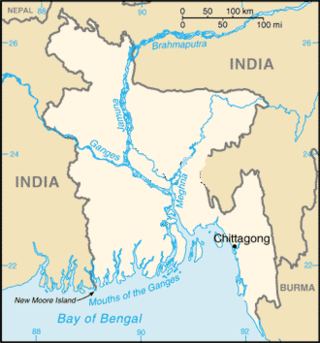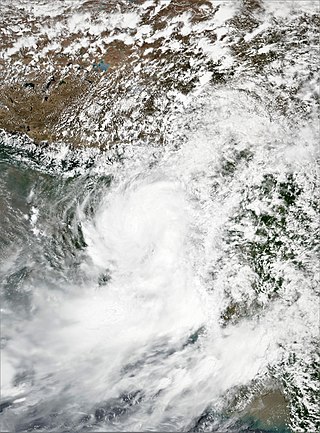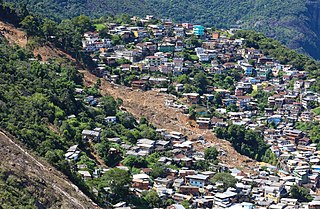Related Research Articles

The Ituri conflict is an ongoing conflict between the agriculturalist Lendu and pastoralist Hema ethnic groups in the Ituri region of the north-eastern Democratic Republic of the Congo (DRC). While the two groups had fought since as early as 1972, the name 'Ituri conflict' refers to the period of intense violence between 1999 and 2003. Armed conflict continues to the present day.

On February 17, 2006, a massive rock slide-debris avalanche occurred in the Philippine province of Southern Leyte, causing widespread damage and loss of life. The deadly landslide followed a 10-day period of heavy rain and a minor earthquake. The official death toll was 1,126.

The 2007 Chittagong mudslides occurred in the port city of Chittagong in south-eastern Bangladesh. On 11 June 2007, heavy monsoon rainfall caused mudslides that engulfed slums around the hilly areas of the city. Experts had previously warned the increasing likelihood of landslides due to the Bangladesh government's failure in curbing the illegal hill cutting taking place in Chittagong.

The 2010 Ugandan landslide occurred in the Bududa District in eastern Uganda on 1 March 2010. The landslide was triggered by heavy rain between 12 pm and 7 pm that day. At least 100 people were believed to have been killed, and 94 bodies were found.

The 2010 China floods began in early May 2010. Three hundred and ninety-two people died, and a further 232 people were reported missing as of June 30, 2010, including 57 people in a landslide in Guizhou. Fifty-three of the deaths occurred from the flooding and landslides between May 31 and June 3, and 266 deaths occurred between June 13 and June 29. Four hundred and twenty four people were killed by the end of June, including 42 from the Guizhou landslide; 277 more were killed and 147 were missing in the first two weeks of July, bringing the death toll as of August 5 to 1,072. A landslide in early August in Gansu killed at least 1,471 people and left 294 missing. In total, the flooding and landslides killed at least 3,185 people in China by August 31. More than 230 million people in 28 provinces, municipalities, and regions, especially the southern and central provinces and regions of Zhejiang, Fujian, Jiangxi, Hubei, Hunan, Guangdong, Guangxi, Chongqing Municipality, Gansu, Sichuan, and Guizhou, and the northeastern province of Jilin were affected, while at least 4.66 million people were evacuated because of the risk of flooding and landslides in the latter half of June. By early August, over 12 million people were evacuated, and that number rose to 15.2 million by August 31.

The 1985 Puerto Rico floods produced the deadliest single landslide on record in North America, that killed at least 130 people in the Mameyes neighborhood of barrio Portugués Urbano in Ponce. The floods were the result of a westward-moving tropical wave that emerged off the coast of Africa on September 29. The system moved into the Caribbean Sea on October 5 and produced torrential rainfall across Puerto Rico, peaking at 31.67 in (804 mm) in Toro Negro State Forest. Two stations broke their 24-hour rainfall records set in 1899. The rains caused severe flooding in the southern half of Puerto Rico, which isolated towns, washed out roads, and caused rivers to exceed their banks. In addition to the deadly landslide in Mameyes, the floods washed out a bridge in Santa Isabel that killed several people. The storm system caused about $125 million in damage and 180 deaths, which prompted a presidential disaster declaration. The tropical wave later spawned Tropical Storm Isabel.

On 30 July 2014, a landslide occurred in the village of Malin in the Ambegaon taluka of the Pune district in Maharashtra, India. The landslide, which hit early in the morning while residents were asleep, was believed to have been caused by a burst of heavy rainfall, and killed at least 151 people. Rains continued after the landslide making rescue efforts difficult.

On 12 June 2017, heavy monsoon rain triggered a series of landslides and floods in Rangamati, Chittagong and Bandarban - three hilly districts of Bangladesh - and killed at least 152 people. The weather also caused power cuts and telecommunications disruptions, making it difficult for rescuers to reach affected communities. Reaz Ahmed, head of Bangladesh's Disaster Management Department, said the landslides were the worst in the country's history.

On the morning of August 14, 2017, significant mudflow events occurred in and around the capital city of Freetown in Sierra Leone. Following three days of torrential rainfall, mass wasting of mud and debris damaged or destroyed hundreds of buildings in the city, killing 1,141 people and leaving more than 3,000 homeless.
The 2020 East Africa floods were a natural disaster in Rwanda, Kenya, Somalia, Burundi, Ethiopia, Uganda, Democratic Republic of Congo, Djibouti and Tanzania, affecting at least 700,000 people. They began when excessive rains began falling in March, leading to massive flooding and landslides. They caused more than 430 deaths, notably in Kenya and Rwanda. In the fall another round of floods hit the African Sahel.

Hispaniola is an island in the Caribbean, with the second largest size throughout all of the Caribbean. Throughout the centuries, since reliable records began, hundreds of hurricanes and tropical cyclones have affected Haiti and the Dominican Republic, the two countries that share the island. The most recent tropical cyclone to affect Hispaniola was Hurricane Fiona in September 2022.
The 2021 floods and landslides in Sri Lanka are flash floods and mudslides which were caused from heavy torrential rainfalls during May and June 2021. As of 7 June 2021; the monsoon floods affected in about 10 districts, killing at least 17 persons including about 10 because of floods and 4 people because of mudslides. About 245,000 people were affected living in Colombo, Puttalam, Kandy, Kalutara, Kurunegala, Gampaha, Nuwara Eliya, Ratnapura and Galle. More than 800 houses were reported to have been damaged.

On 15 February 2022, intense rainfall in Petrópolis, Rio de Janeiro, Brazil caused mudslides and flooding that destroyed parts of the city. At least 231 people died in the disaster.

In April 2022, days of heavy rain across KwaZulu-Natal in southeastern South Africa led to deadly floods. Particularly hard-hit were areas in and around Durban. At least 435 people died across the province, with an unknown number of people missing as of April 22. Several thousand homes were damaged or destroyed. Critical infrastructure, including major roads, transportation, communication, and electrical systems, were also impacted by the flooding, and this damage greatly hampered recovery and relief efforts. It is one of the deadliest disasters in the country in the 21st century, and the deadliest storm since the 1987 floods. The floods have caused more than R17 billion in infrastructure damage. A national state of disaster was declared.

Typhoon Chebi was a powerful tropical cyclone that caused damage and deaths in five countries, the Philippines, Taiwan, China, South Korea, and Japan. The fourth depression, second named storm, and first typhoon of the 2001 Pacific typhoon season, Chebi formed from an area of convection that developed into a tropical depression southeast of Palau. The depression quickly strengthened into Tropical Storm Chebi six hours later. Chebi continued to move westward, passing over cooler waters, which caused Chebi to weaken, but it still maintained tropical storm status as it entered the Luzon Strait on June 23. In the Luzon Strait, Chebi encountered favorable conditions and began to re-intensify. By June 23, Chebi had reached Category 1- equivalent typhoon status. The storm continued to strengthen overnight, and by June 24, Chebi had reached its peak intensity. A trough of low pressure to the north of Chebi caused the storm to turn westward and then northwestward. That same day, Chebi made landfall near Fuzhou City. The storm then weakened rapidly as it moved inland, and by June 25, Chebi's remnants were over China. The remnants of Chebi continued to move northward, and on June 30, they dissipated.
Events of the year 2023 in the Democratic Republic of the Congo.
Since 5 February 2023, floods have killed over 2,200 people in 15 countries across Africa.
The 2023 African Great Lakes floods are floods in April and May 2023 that have killed hundreds of people in the Democratic Republic of the Congo, Rwanda and Uganda.
References
- ↑ Congo Mudslide: Recent Disaster A Cause For Concern For Africans. Stephanie Ekowa, August 19, 2017.
- ↑ Landslide kills 40 in northeast DR Congo, The East African. Thursday August 17, 2017.
- ↑ Freytas-Tamura, Kikiko (19 August 2017). "Landslide in Congo Kills Dozens, Official Says". The New York Times . Retrieved 21 August 2017.
- ↑ "Congo mudslide death toll 'to rise to 200'". BBC . 19 August 2017. Retrieved 21 August 2017.
- ↑ "Congo landslide death toll likely to rise over 200 — Ituri vice governor". Arab News . 19 August 2017. Retrieved 21 August 2017.
- 1 2 "DR Congo landslide death toll climbs to 200". Al Jazeera . 19 August 2017. Retrieved 21 August 2017.
- ↑ "Landslide kills 40 in northeast DR Congo". Relief Web . 17 August 2017. Retrieved 21 August 2017.